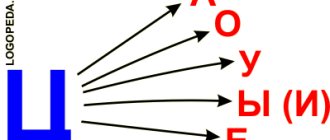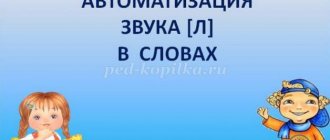Who can teach a child to say the letter R?
The speech therapist will play one of the most important roles in the formation of the baby’s speech. However, the most important participants in the process will be parents. The success or failure of training depends on them.
It should be understood that to correctly form pronunciation you need to put in much more effort than, for example, learning to swim. Indeed, in the case of words, the emphasis is not on technique, but on the development of the articulatory apparatus. Therefore, parents should:
– create a schedule of activities with your child;
– do not miss a single day of training;
– choose the most interesting and exciting games and exercises;
– make classes fun;
– have incentive gifts on hand;
– be patient for a couple of months in advance;
– don’t expect quick results.
Only after this can we talk about parents’ readiness to help their child correct their pronunciation.
When correction is needed
The sound “R” is one of the most difficult sounds in a child’s speech development. It belongs to the category of sonorants, in which there are more vocal tones than noise.
Experts put “P” last, when all other sounds have already been correctly formed and consolidated. The production of “R” begins after 5.5-6 years . Until this time, a violation in his pronunciation is the age norm.
In some cases, it is worth contacting a speech therapist from the age of 4 , when “R” appears in speech, but does not manifest itself correctly. In this variant, the child does not replace “R” with other sounds (“L”, “V”), but tries to pronounce “R”, but with disturbances in the articulatory apparatus.
Norm for pronunciation of “R”:
- lips are relaxed;
- distance between teeth 4-5 mm;
- the tip of the tongue rises to the upper gums;
- the tongue vibrates in the air stream;
- the middle part of the back of the tongue arches;
- the back of the tongue is directed back, pressed against the palate;
- the side edges are pressed upward;
- The vocal folds vibrate when speaking.
Violation of the pronunciation of hard “P” and soft “Pb” in defectology is called rhotacism or pararotacism. In Soviet times, these violations were called burrs.
The main types of rhotacism that require correction:
- Velar. The tip of the tongue is lowered down and does not participate in articulation. The tongue is tense and pushed back. There is little voice in pronunciation, a lot of air. The sound is guttural and loud.
- Uvular. The tongue vibrates in the air stream. The sound is soft, quiet, smooth.
- Nasal. The air is directed into the nose, there is no vibration.
- Bilabial. Only the lips, without the tongue, take part in articulation.
- Slotted. The tongue is directed upward and forms a gap with the soft palate. The sound changes to “Z” or “Zh”.
- Interdental. The tongue is between the teeth.
Stages of correction of violations:
- Preparatory.
- Sound production.
- Automation.
- Differentiation.
- Consolidation in speech.
Bogomolova method
A.I. Bogomolova in 1979 proposed a method for generating vibration for saying “R”. The teeth are open to a distance of 2 fingers. The tongue is pressed against the palate, stretching the frenulum as much as possible. The teacher moves the edges of the tongue towards the palate with his fingers, while the frenulum is free.
The child takes a deep breath and blows it out sharply, using his voice. The combination “TZ” is formed. Repeat the exercise, gradually increasing the air pressure. The sound combination “TLE” will change to “TR”. After fixing the short “TR”, they practice the rolling “TR” with the help of fingers, and then without them.
Sound Automation
In order to put the sound “r” and consolidate your achievement, perform exercises to automate the sound: learn and pronounce tongue twisters, rhymes, and tongue twisters.
The production of the soft sound “r” is done after the pronunciation of the hard “r” is fixed.
Exercises for pronouncing the letter “r” in this case are pure phrases with a soft “r”:
Tongue twisters are great for putting a soft “r”
Various tongue twisters and nursery rhymes will become additional practice and will help the child consolidate the acquired skills in pronouncing the letter R. They will also develop general articulation, besides, this funny type of repetition always gives children great pleasure and charges them with a positive attitude.
Exercises with tongue twisters can be carried out in the form of competitions between the baby and other family members, regardless of how old someone is. Examples of tongue twisters:
Speech exercises
For the development of the speech apparatus, general language gymnastics is necessary. It must take place in a playful way. 3-4 times a day for 10-15 minutes. The baby needs to be interested so that he has a desire to do this gymnastics. How to do this is the concern of each parent individually.
So, let's look at an approximate set of exercises.
- Exercise 1: play a game with your child to see who can reach the tip of their nose with their tongue
- Exercise 2: roll your tongue into a tube, stick it out of your mouth and blow into your tongue
- Exercise 3: use the tip of your tongue to reach your upper teeth and say the letter “d”
- Exercise 4: play around with your tongue, stick it out of your mouth and swing it in one direction and the other.
- Exercise 5: tell your baby that your tongue is a toothbrush, and you need to brush all your teeth with it on all sides.
In addition to these exercises, parents can come up with others, the main thing is that they are done in a playful way and the child likes them.
Do not require your child to immediately pronounce words with the letter r. Start with simple ones, gradually moving to more complex ones. Try to show him how to growl first, and let him repeat it. Then, if you already get a single letter “r”, practice saying syllables with this letter “ra, ro, ri, re, rya, ru”. And after syllables have begun to form, you can move on to words with the letter “r”.
Don’t forget that an important point when working with children is psychological. A 5-year-old child is already big and notices his defect himself; it is possible that his peers constantly tell him about it. Therefore, the main thing is not to “overdo it”. During classes, encourage the child and praise him.
Note to parents. Don’t despair, if you have confidence in your abilities, in the abilities of your baby, then he will try and everything will work out for him.
Sound production methods
Basic staging techniques:
- By imitation - the child’s attention is fixed on movements, positions of the organs of articulation using visual and auditory control.
- Mechanically - using speech therapy probes, spatulas, hand tools.
- Mixed method - production from other sounds.
The period for fixing the correct sound is from 25 to 60 days. Lessons are held 2 times a week, without a speech therapist at home they study daily.
Breathing exercises
- " Bubble ". You need to blow out as many soap bubbles as possible in one exhalation. Take a very deep breath and exhale strongly and long. Inhale again and imagine that you are blowing an even larger soap bubble.
- " Flying Feather " Inhale through your nose. Now, slowly exhaling through your mouth, blow a feather (a piece of cotton wool) from your palm.
Lip exercises
- " Angry dog ". Show me how an angry dog growls.
- " Dudochka ". We make a long pipe out of our lips.
- " Frog ". The frog has a mouth, as they say, “from ear to ear.” To portray it, you need to smile very widely.
- " Whale ". We puff out our cheeks. A whale swims in the blue sea, we puff out our cheeks strongly.
Tongue exercises
- " Needle ". Try to make the tongue narrow and sharp. It turns out? Show me.
- " Horse ". The horses' shoes click loudly on the pavement. Let's depict this sound with our tongue.
- " Sweet tooth ." How do you lick your lips if there is delicious jam left on them?
- " Swing ". Try to reach your nose with the tip of your tongue. And now - up to the chin. Need to repeat several times.
- " Painter ". When painting the ceiling, you need to move the tip of your tongue back and forth across the sky. The brush is our tongue, we will paint the ceiling.
- " Tube ". We stick out the tongue in the shape of a tube.
- " Sail ". We open our mouth. We place our tongue up behind the teeth and begin to blow on the tongue, as if the wind is inflating a sail.
Exercises for stretching the frenulum of the uvula
Usually massage and special exercises help stretch the short frenulum of the tongue. It is better to conduct these activities in a playful way. A little patience, and the coveted “r” will appear.
- " Kitty ". The kitten eats milk, scooping it up with its tongue. Can you show how?
- Home massage . After the speech therapist shows options for frenulum correction, massage can be performed at home.
Articulation gymnastics before classes
Automation of the sound “R” in words begins with the preparation of the muscles of the speech apparatus. Articulation gymnastics are widely used for this purpose. Pre-warmed muscles help you cope with incorrect pronunciation faster and more successfully.
- The first exercise is called “Naughty Tongue”. To perform it, you should smile with your mouth open, place your tongue on your lower lip, biting it slightly with your teeth. In this position, you need to say: “five-five-five” for 10 seconds.
- Second lesson “Shovel”. It is done this way: you need to open your mouth, smiling, put a wide tongue on your lower lip and fix this state for 5 seconds. You will need to do this 3 times.
- The third good exercise is the Turkey Punch. The child will need to open his mouth, smile and move the wide front edge of the tongue back and forth across his upper lip. In this case, you cannot tear yourself away from your lip, and bend the tip slightly upward. You should start the exercise slowly and then gradually increase the speed of movements.









